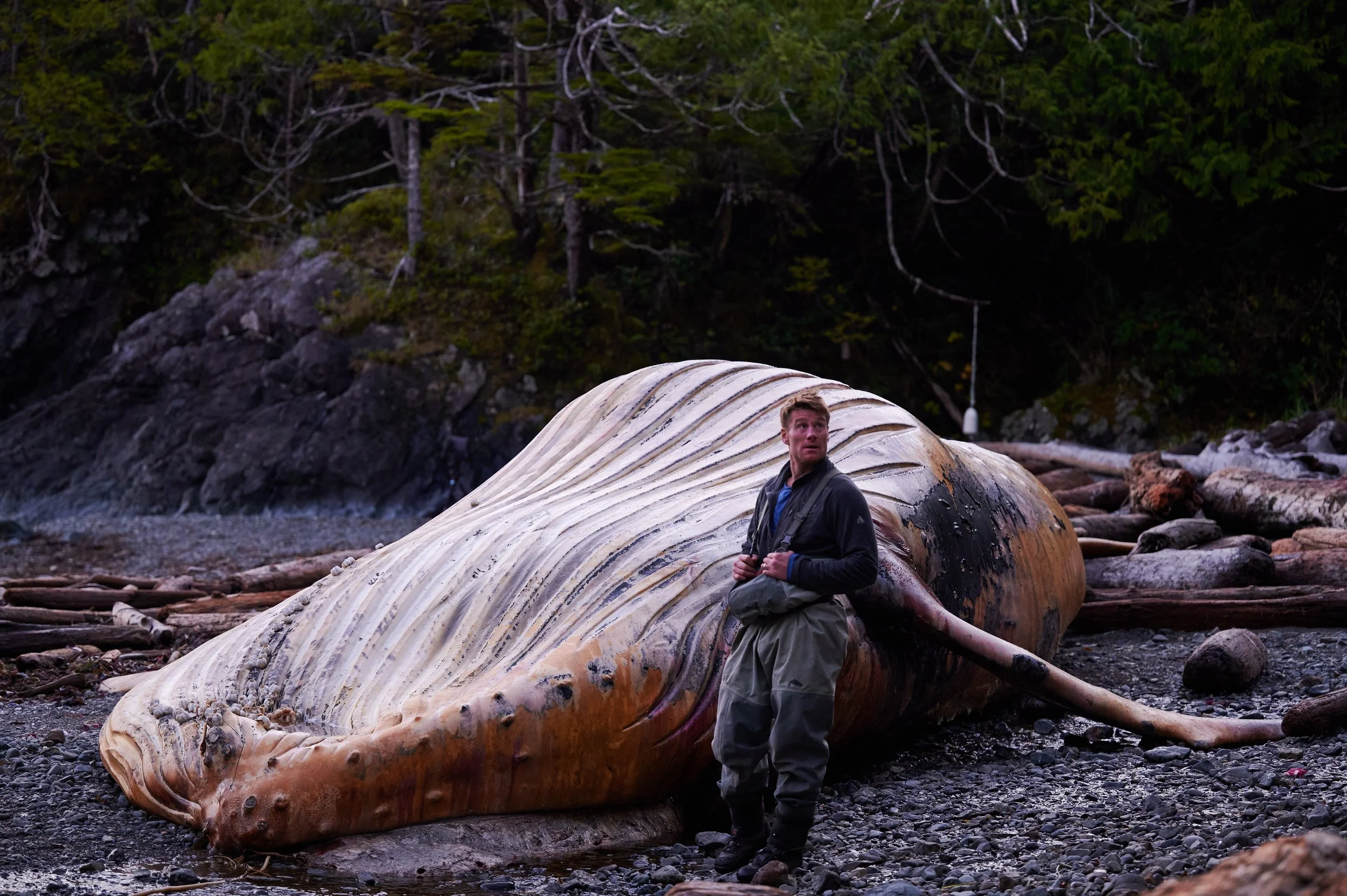In this Episode of Deep Sea BC, Captain Quinn searches for giant man eating lingcod, rock fish, yellow eye and the rare and discovers a rare and endangered glass sponge reef. Fishing has always intrigued me as not only a means to food but also a means to explore the natural world and connect with a place that is beyond my evolutionary reach. You drop a line into a world beneath the water and if you’re lucky you pull something up. I’ve seen some pretty large lingcod over the years but I’ve heard rumours of lingcod reaching monstrous proportions. These giants have been documented at over 1000 feet below the sea and have been caught weighing over 80 lbs. Because of their anatomical design and highly aggressive feeding behavior they are capable of swallowing prey up to 80 percent of their size. They like to hide in rocky areas with significant current where they can ambush passing prey, it is in these areas that some of the largest Lingcod are rumoured to live. Female lingcod begin to mature at 3 to 5 years of age at an average length of 24 to 30 inches. Males begin to mature at age 2 at a length of 20 inches. The number of eggs per mature female increases with both size and age. Along the Alaska coast, lingcod begin spawning in early December, with peak spawning occurring from mid-January to mid-March. After the eggs are deposited and fertilized in nests in crevices along the reefs, the female lingcod disperse to other areas and leave the male lingcod to guard the egg nests until the eggs hatch which takes from 5 to 11 weeks. Thus, while most egg masses hatch between mid-March and mid-May, some hatching occurs into June. Egg nests, if left unguarded, are generally decimated within 48 hours by rockfish, starfish, sculpins, kelp greenling, and cod. The presence of a male to guard the nest from these predators appears essential for successful spawning. Unfortunately, nest-guarding males are extremely aggressive and vulnerable to predation by seals, sea lions, and anglers. Removal of a male during the nest-guarding period not only results in removal of the fish from the adult spawning population but also results in the likely loss of that male’s nest, thereby affecting future recruitment. Larval and juvenile lingcod are preyed upon by fishes such as salmon, rockfish, and other lingcod. Glass sponge reefs are one of several species of deep-water coral that exists in the Strait of Georgia. In addition to glass sponge reefs, red tree coral can also be found. These coral reefs can absorb more carbon out of the atmosphere as old growth forests and provide habitat for a variety of marine animals. They also clean, circulate and oxygenate the water. Captain Quinn is here to bring you Fishing Comedy & The Great Outdoors! Subscribe for more: https://bit.ly/2RE3o2o Instagram: https://www.instagram.com/thecaptainq...
DEEP SEA BC S1 EP2
In this Episode of Deep Sea BC, Captain Quinn searches for Deep Water Sharks. Can he find the elusive 20 foot six gill shark, Dog Sharks and the bizarre Rat Fish? Dog sharks can still be found in moderate numbers throughout the Salish sea and are very impressive creatures. They are not known for their size but like most sharks they help turn dead animal flesh into valuable nutrients for their marine neighbour's. They are considered predators as well as scavengers and are fished commercially. If you have ever eaten fish and chips in England, there is a good chance you have eaten this particular shark. This shark can live in the deep as well, and due to their keen sense of smell can likely be found where there are large amounts of fishy flesh. Ratfish are related to sharks and are incredibly bizarre looking creatures with a venous spike located near their tale. Seals and sealions have succumbed to this venomous spike after consuming the ratfish and receiving a puncture to their stomach wall from this spike. Their large eyes allow them to inhabit a variety of depth from 100 feet down to thousands of feet. Not much is discussed about the role they play in the ecosystem but you can bet, like every other marine creature, it is significant. They are often caught as bycatch in commercial and recreational fisheries. Sixgill shark tours used to be sold at the dive shop in Courtney, BC. Scuba divers used to swim with these giant deep-sea sharks (up to 20 ft long) off of the south tip of Hornby Island. Sadly, these sharks have not been seen in the area for nearly 20 years. The odd fishermen reports hooking something that tows their boats around for hours only to straighten their hooks out or finally snap their line. Could these be clues as to this shark’s whereabouts? These sharks are true deep-sea creatures with little known about them. They only come into shallower water once a year in the spring time. Where have they gone and why? What is their role in upholding the health of our marine ecosystems? Captain Quinn is here to bring you Fishing Comedy & The Great Outdoors! Subscribe for more: https://bit.ly/2RE3o2o Instagram: https://www.instagram.com/thecaptainq...
DEEP SEA BC S1 EP1
In this episode of Deep Sea BC, Captain Quinn explores the deep depths of the Strait of Georgia in the Salish Sea in search of mysterious deep water crustaceans. Can he find and document the Brown Box crab, Pacific Spot Prawn and or the Pandalus Borealis Shrimp in their natural deep water habitats? What else might he discover as he combs the ocean floor with his submersible remote operated vehicle? The deep sea is home to many wild, bizarre and mysterious creatures. Can he find some of them? Maybe he will find a rare and unique animal, a sea monster or perhaps a mermaid? In addition to holding many mysteries the sea is also a place of bounty with food available almost everywhere you look. When they hatch, all crustaceans float around in the ocean currents as microscopic Zooplankton, filling the waters with life. After a while, they finally settle on the ocean floor and begin to grow. Shore crabs were probably one of the first marine animals I came to discover, they are under almost every rock in the intertidal zone up and down the BC coast. They are common and widely recognized like other common shoreline species such as the starfish. They spend part of their day on land as the time goes out and part of their day underwater as the tide comes in. There are many different species of crabs in the Salish sea. Some like the shore crab live part of their lives on land and others like the red rock crab and Dungeness crab spend their time scavenging in subtidal areas. Crabs, like shrimp, are crustaceans. Instead of bones they have a hard exoskeleton which must be moulted inorder for the animal to grow. Some crustaceans like shore crabs, dungeness and red rock crab commonly encountered by humans and live in places that are easily accessible by humans with masks and snorkels but what about the crustaceans that live deeper? Much deeper. Beyond the natural reach of humans such as spot prawns, pandalus borealis shrimp and the rarely observed robust brown box crab. As is the case with most marine life, the deeper they live the less we encounter and interact with them, the less we seem to know about them. And so we are grabbing our traps, our masks and snorkels and our remote operated vehicle and we are setting out to explore the marine environments that the crustaceans of the Salish Sea call home. Captain Quinn is here to bring you Fishing Comedy & The Great Outdoors! Subscribe for more: https://bit.ly/2RE3o2o Instagram: https://www.instagram.com/thecaptainq...
Wildlife Reel 2021
Skeena Salmon & Steelhead Film
A fishing film for the future of fish in the Skeena river in Northern BC, Canada. From traditional subsistence fishing economies to commercial fishing and canneries to double hand fly fishing, guide outfits and eco-tourism to present day fishing closures in the Pacific Northwest. What does the future of salmon fishing in Northwestern BC look like? Meet all the stakeholders of fishing in NWBC today and learn about the cultural, subsistence, spiritual and economic significance of fish to each user group. Visit old canneries gone ghost town. Hear from First Nations, Commercial Fishermen, Guides, Recreational Fishermen, Fish Hatcheries and Eco-Tourism Leaders. Follow the timeline of fishing economies and practices in the Skeena River and ask yourself if its possible for all the stakeholders in the Skeena to put their differences aside and put the fish first.
Captain Quinn is here to bring you Fishing Comedy & The Great Outdoors! SUPPORT CAPTAIN QUINN TO PRODUCE MORE CONTENT BY SUBSCRIBING TO HIS CHANNEL AND FOLLOWING ON INSTAGRAM Subscribe for more: https://bit.ly/2RE3o2o Instagram: https://www.instagram.com/thecaptainq... Check out More Awesome Videos in the Following Playlists: Fishing Films: https://bit.ly/2UHkOxa FISHING // Captain Quinn: https://bit.ly/2BfOKcn COMEDY // Captain Quinn: https://bit.ly/2TxTam7 OUTDOORS / HOW TO VIDEOS / SURVIVAL: https://bit.ly/2HRcB7X Buy a Captain Quinn Fishing Gear http://www.skeenafish.ca/ www.captainquinn.com

